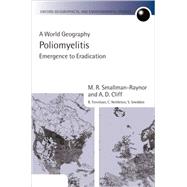
Note: Supplemental materials are not guaranteed with Rental or Used book purchases.
Purchase Benefits
What is included with this book?
| List of Figures and Plates | xvii | ||||
| List of Tables | xxvii | ||||
| Acknowledgements | xxxiii | ||||
| 1. Introduction | 1 | (23) | |||
|
1 | (2) | |||
|
3 | (3) | |||
|
6 | (11) | |||
|
17 | (4) | |||
|
21 | (3) | |||
| 2. The Nature of Poliomyelitis | 24 | (37) | |||
|
24 | (1) | |||
|
25 | (5) | |||
|
30 | (8) | |||
|
38 | (6) | |||
|
44 | (9) | |||
|
53 | (6) | |||
|
59 | (2) | |||
| 3. The Pre-epidemic History of Poliomyelitis (Antiquity to AD 1880) | 61 | (20) | |||
|
61 | (1) | |||
|
62 | (6) | |||
|
68 | (4) | |||
|
72 | (5) | |||
|
77 | (4) | |||
| Part I Epidemic Emergence, 1881-1920: Early Centres and Localized Outbreaks | |||||
|
81 | (47) | |||
|
81 | (1) | |||
|
82 | (7) | |||
|
89 | (19) | |||
|
108 | (14) | |||
|
122 | (5) | |||
|
127 | (1) | |||
|
128 | (61) | |||
|
128 | (1) | |||
|
129 | (5) | |||
|
134 | (16) | |||
|
150 | (24) | |||
|
174 | (3) | |||
|
177 | (3) | |||
|
180 | (9) | |||
| Part II Global Expansion, 1921-1955: Epidemic Poliomyelitis in the Pre-vaccine Era | |||||
|
189 | (242) | |||
|
191 | (66) | |||
|
192 | (2) | |||
|
194 | (5) | |||
|
199 | (3) | |||
|
202 | (13) | |||
|
215 | (6) | |||
|
221 | (10) | |||
|
231 | (24) | |||
|
255 | (2) | |||
|
257 | (53) | |||
|
257 | (3) | |||
|
260 | (22) | |||
|
282 | (6) | |||
|
288 | (11) | |||
|
299 | (9) | |||
|
308 | (2) | |||
|
310 | (76) | |||
|
310 | (1) | |||
|
311 | (6) | |||
|
317 | (34) | |||
|
351 | (13) | |||
|
364 | (16) | |||
|
380 | (5) | |||
|
385 | (1) | |||
|
386 | ||||
|
386 | (5) | |||
|
391 | (14) | |||
|
405 | (5) | |||
|
410 | (2) | |||
|
412 | (6) | |||
|
418 | (7) | |||
|
425 | (3) | |||
|
428 | (3) | |||
| Part III Global Retreat, 1955-1988: Returning Localized Outbreaks | |||||
|
431 | (2) | |||
|
433 | (36) | |||
|
433 | (2) | |||
|
435 | (7) | |||
|
442 | (14) | |||
|
456 | (6) | |||
|
462 | (6) | |||
|
468 | (1) | |||
|
469 | (92) | |||
|
470 | (2) | |||
|
472 | (6) | |||
|
478 | (18) | |||
|
496 | (15) | |||
|
511 | (12) | |||
|
523 | (12) | |||
|
535 | (7) | |||
|
542 | (14) | |||
|
556 | (1) | |||
|
557 | (4) | |||
| Part IV Global Eradication | |||||
|
561 | (2) | |||
|
563 | (68) | |||
|
563 | (1) | |||
|
564 | (7) | |||
|
571 | (4) | |||
|
575 | (33) | |||
|
608 | (15) | |||
|
623 | (5) | |||
|
628 | (3) | |||
| Appendix | 631 | (41) | |||
| References | 672 | (39) | |||
| Index | 711 |
The New copy of this book will include any supplemental materials advertised. Please check the title of the book to determine if it should include any access cards, study guides, lab manuals, CDs, etc.
The Used, Rental and eBook copies of this book are not guaranteed to include any supplemental materials. Typically, only the book itself is included. This is true even if the title states it includes any access cards, study guides, lab manuals, CDs, etc.